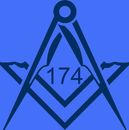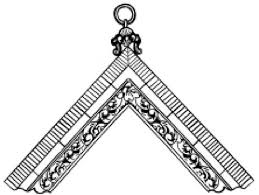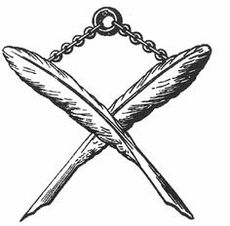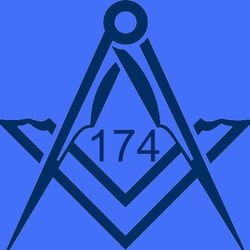About Us
When do we meet ?
Regular Meetings -
2nd Tuesday of the month, Oct - Apr
Please check our Upcoming Events page for details of meetings and special Events
Next regular Meeting
The History of 174
This brief record of Lodge St. John, Dunning, (Originally No 233 but altered in 1827 to 174) has been compiled from minute books and correspondence. When one considers that the Lodge had numerous meeting places during its first hundred years, was in abeyance for some 25 years, found its present home in 1924 (although ousted by the army during the war) it is surprising how many old records are still in existence.
The perusal of the old minute books makes monotonous reading being mainly concerned with degree and benevolence. There are, however, old snippets of information which assist with this history. Other items are extremely intriguing though frustrating - such as the minute of 23rd February 1860, which states "some trifling business was attempted and partially bumbled". No further clues could be found. The first entry in the minute book states, "A Company of Masons to the number of about 30 in and in the neighbourhood of Dunning finding it inconvenient to attend at Auchterarder, their mother Lodge met and drew up a Petition to the Grand Lodge, praying for a Charter to erect them into a regular Lodge". This petition was supported by the Royal Arch and St. Andrews Lodges in Perth and St. John Lodge in Auchterarder and was presented to Thomas Hay Esq, Sub. Grand Master of the Grand Lodge of Scotland on Tuesday 17th November 1789. As such petitions could be dealt with only at Quarterly Communication an order date’s 18th November 1789 was signed allowing brethren in Dunning to hold regular assemblies from that date up to 1st March 1790. A Charter was granted dated 1st February 1790, signed by Lord Napier, the 37th Grand Master Mason of Scotland.
The first meeting of the Lodge was held on 21st November 1789 to hear the result of the Petition. Mr E. Paterson, schoolmaster, was the first entered apprentice, being initiated on 23rd November. He was appointed Secretary on 9th December, and we have him to thank for the original minutes and articles and regulations of the Lodge. This was Dunning Operative Lodge, and Article 2 stated "it is the wish of the members of the Lodge, to admit as few as possible of such as are not operatives". This implies that the original members who petitioned for a Lodge in Dunning were operative masons, further implying that the building trade in Dunning was flourishing during that period. The original 8 members listed on the 21st of November were David Black, David Smiton, Andrew Cunningham, Rollo Campbell, Patrick McEwing, William Meechie, Alexander Bonzie, Alexander Pearson, Robert Marshall, David Todd, Alexander Wilson, Robert Whyte, William Paterson, Pat Chalmers, Magnus Wilson, John McIntyre, John Miller, Andrew Flockhart. The first Master was David Todd.
The new Lodge flourished and by the 1st of February 1792, 20 new members had been initiated. The word "Operative" was deleted from the Articles in that year.
From its inception until December 1833 (passing of Act of Parliament for Friendly Societies) the Lodge was greatly involved in payment of sickness and unemployment benefits and death grants. Death grants were still paid up to April 1852, when the friendly part of the Lodge ceased, and the balance of these funds divided amongst the members. Many of the original Articles deal with this part of the Lodge activities, setting out the rules for payment or non-payment. For example, Article 10 states no benefit if illness is consequent or quarrelling and fighting, or any intemperance which tends to disable the human frame.
The articles also detail the number of meetings each year, types and amounts of benefits and various fines for non-attendance, cursing or swearing in the Lodge or being drunk and interrupting meetings.
Members should be upright and law-abiding citizens and Article 32 states "any member behaving badly so as to be notorious for drunkenness, street wrangling, frequenting houses of bad fame, and be guilty of such disorderly conduct so as to bring a stain on the society. Fine 3/-, second offence - excluded from the Society".
Brethren were expected to attend all meetings. Article 11 lists the meetings - 4 quarterly and the Cleansing Meeting held 8 days before St. John's Day. Members arriving after the appointed hour paid 1p. If the book was closed, he was treated absent and paid 2p to every private member and 6p to every manager.
The 4 quarterly meetings were for collecting dues, paying expenses and benefits and dealing with candidates. The Cleansing Meeting was held to clear up all debts and accounts prior to the annual meeting on St. John's Day. Brethren were appointed to check the accounts of the box masters who handled the funds |No doubt when bank accounts took over, the title of box master fell into abeyance. Another title which has been lost is Croupier (the original meaning being chairman at public dinners). At each dance or function of the Lodge croupiers were appointed to manage the procedure. I was pleased, recently, to find this title still being used in another Lodge.
The Lodge was also involved in purchasing meals during harvest time for resale in the neighbourhood during the year. It was, in reality, a benefit society only secret in that its meetings were open to members only.
In the early years, the Lodge took in a large area of the surrounding countryside, which was divide into district with a manager appointed at the annual meeting to oversee each district. The districts were:
- Forgandenny, Dunbarnie and Dron parishes.
- Forteviot and Aberdalgie parishes, Cherrybank.
- Gask parish.
- Perth.
- Bridge of Earn.
The Brethren of Dunning were very supportive of other Lodges for various ceremonies outside the local area. In 1794 they supported a petition to Grand Lodge for a Charter for Muthill Lodge. In 1816 21 brethren went to Crieff to meet the Provincial Grand Master of Perthshire. Brethren attended many laying of foundation stone ceremonies. The most important (from a perusal of minutes) was the Laying of the Foundation Stone of the Wallace Memorial in 1861. On this occasion the Lodge opened in the morning, adjourned, then paraded with the Dunning Band to the railway station, entrained to Stirling to attend the ceremony, returned in the everting with the Band to parade back to the Lodge to reopen and close, finishing with dinner and harmony. Part of the foundation stone was brought back and was inserted in a silver surround by a Perth jeweller. This was originally the jewel of office of the RWM and is now the Chaplain's badge of office. This occasion was marked by a special harmony for several years. Among the many other foundation stone ceremonies attended over the years were: -
- City and County Infirmary of Perth,
- Sir Walter Scott Memorial in Edinburgh,
- New Post Office in Glasgow
- Police Building in Perth
- Swimming Baths in Perth
The Lodge appears to have periods of ups and downs. In the 1830s very little happened. In the 1840s membership was sufficient to hold a procession for St. John's night followed by a dance. In the 1850s there was only about one meeting per year, but again in I860 the local Musical Brass Band was engaged to head a procession to escort the RWM to the Lodge on St. John's Night.
In December 1862 we find that the first mention in minutes of the Lodge being opened in the first degree and afterwards in the second and then third. This was done several times to enable the office bearers to become acquainted with the correct, procedure. Originally new members of the Lodge received all their degrees in one meeting. It was f not until June 1877 that we find a mention of a degree on its own at a meeting.
From 1868 the Lodge decreased until in 1.876 it consisted of only 6 members. However, with the assistance of visiting brethren 6 new members were put through their degrees.
In 1877 Lodge Scone & Perth No 3 celebrated Summer St. John by paying a visit to Lodge St John Dunning No 174. The whole company, headed by the RWM of 174, and with pipers playing and banners flying, walked in procession to Duncrub House, the residence of the Rt. Hon. Lord Rollo and Dunning, where a delightful time was spent in the beautiful grounds. On returning to Dunning, the brethren were hospitably entertained and spent a pleasant social evening and parted with good wished for each other.
The 1880s found the Lodge Ln an upsurge once more with sufficient members to arrange summer festivals of St. John in July as well as the annual festival in December with dinner and harmony followed by a dance. In 1881 the summer trip was a visit to Lodge St. John No 46 with a cold buffet at Auchterarder and dinner back at the Lodge on their return. In 1888 a party of 1.4 members and Lady friends had a day's outing in a brake and pair of horses to Glenfarg and Damhead.
In the 1880s Lodge 174 had a Long disagreement with P.G.L. about the annual levy. With membership so small the brethren felt that a flat Levy of £1 was unfair to small Lodges and suggested that a payment of so much (say 2/6) per initiate would be a better method for raising funds for P.G.L. This argument, which started in L882 was eventually settles in 1888.
One interesting minute in December 1889 mentions the procession "headed by the Tyler attired in his quaint oriental dress". It is a pity that such attire is now lost in the past.
The Lodge was in good health during this period. In L890 a Grand Bazaar was held to raise funds for Grand Lodge Benevolent Fund. A committee was formed consisting of RWM, DM, Treasurer and no less than 12 ladies from Dunning. They were very successful in ensuring that Dunning contributed to this worthy cause.
The centenary of the Lodge was celebrated on 2nd October 1890. This was graced by the presence of Lt. Col. Campbell Dep. P.G.M. of Perthshire East. After meeting in the Lodge, a torch light procession headed by the Village Flute Band, paraded through the streets to the Town Hall. A concert was held to a large and appreciative audience. Afterwards the hall was cleared for dancing, which was kept up with great spirit till an advanced hour next morning.
After this the Lodge went into decline. Many meetings were held in 1891, but few members appeared. In 1892 and 1893 the only meetings were to receive the Provincial. Grand Lodge. 1894 and 1895 saw a slight improvement, but eventually the Charter had to be surrendered for lack of members, the final meeting being on 18th February 1898.
In 1923 several masons headed by Br. D. Alexander petitioned Grand Lodge for resuscitation of Lodge 174. This was granted and the Lodge was rededicated by the Earl of Elgin, the 84th Grand Master Mason of Scotland on 17th October 1923, in ' the Village Hall. Two of the original members of the Lodge, Bro John Murray and Bro Johnstone Wright were present at the rededication ceremony.
The new Lodge prospered, and by the Provincial Visitation on 7th April 1924, there had been 18 Initiates and 20 Affiliates.
During the period 1923 to 1926 many degrees were worked by other Lodges, who offered their services to assist the new brethren to become established. The Trades House of Glasgow Lodge No. 1241 were frequent visitors as was Lodge St. John No. 46 of Auchterarder. 174 office bearers gradually took over the degree work, but it was not until 1950 that we find the first working of a mark degree by 174.
The 1930s were a poor period in Dunning, from 1931 to 1936 there were no Initiates and only 4 Affiliates. 1937 saw 3 Initiates, but only 2 more until 1945.
Since then, the Lodge has been fortunate for a Country Lodge in having a steady supply of candidates and has kept, working during the years, Unfortunately,' like many Lodges, the number initiated bears little relation to the number of regular attenders. However, there has always been sufficient keen members to keep the Lodge operating. No doubt the celebration of the 200th anniversary in 1990 will herald a renewal on interest in Lodge St. John Dunning
Lodge Meeting Places
On 5th August 1790, the meeting agreed to have a regular meeting place and a room was hired "in a new house at present finishing by David Kinmonth". This house was in Auchterarder Road (then the High Street) opposite the present Town Hall. This was the first of the many meeting places of the Lodge. In .1797 it was voted to take a piece of ground to build a house for a Lodge. In 1809 it was again voted to build, and estimates were to be sought. The next mention is in 1823 when a committee was appointed to inspect a house for sale and to check if worth buying. Meanwhile the Lodge meeting place was a variety of private rooms although between 1845-60, 1864-76 and 1879-86 it alternated between the Kirkstyle Inn and the Bridge End Inn. Eventually in 1886 the Lodge ended up at the house in Station Road until the surrender of the Charter in 1898.
The present meeting place, which was a former U.F. Church, was purchased in 1924. Most of the price was raised by subscription from the members, but it took until 1933 to eventually clear the balance. The first meeting was held on 28th November 1924, when it was consecrated by the R.W.P.G.M. of Perthshire East, Bro. the Rev. A Wylie Smith.
It appears that feelers were put out for other premises in 1950. A minute of 14th March proposed that the Secretary obtain chairs in Duncrub Chapel should present negotiations for purchase of complete Chapel break down. The negotiations must have broken down as the Lodge has not moved.
In the early 1970s a meeting was called to discuss the Lodge building and decided it would be better f6r the Lodge to build an upstairs Lodge room, leaving the present room downstairs to be divided into kitchen, toilets, and an area to be used for functions. This work was undertaken by the operative masons with the assistance of their non-operative brethren. The work was done over several years. The Dedication ceremony was performed by Br. D MacGregor, R.W.P.G.M. Of Perthshire East on 7th March 1980, when 17 Lodges were represented.






